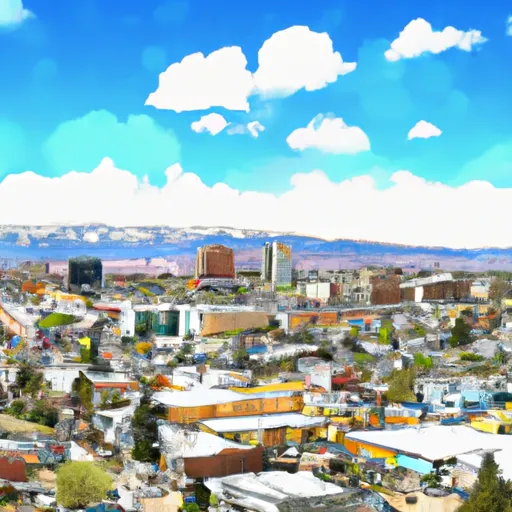-
 Snoflo Premium
Snoflo Premium
Get unlimited access to all our content
With no Ad interruptions! - Start Your Free Trial Login with existing account
Sparks
Eden Index
Climate
8.8
•
Recreation
3.5
•
Community
2.2
•
Safeguard
5.3/10

Sparks, Nevada is a city located in Washoe County, in the western region of the United States. Known for its arid climate, Sparks experiences hot, dry summers and cold winters. The city has a semi-arid climate characterized by low precipitation and high evaporation rates. Summers often reach temperatures exceeding 90°F (32°C), while winters can dip below freezing, with occasional snowfall.
Hydrologically, Sparks is situated near the Truckee River, which flows through the city and provides water resources for both recreational activities and residential use. The river also offers opportunities for fishing, kayaking, and rafting.
Outdoor enthusiasts can explore various recreational activities in Sparks. The city is surrounded by picturesque mountains, making it ideal for hiking and mountain biking. Nearby parks, such as Sparks Marina Park, offer opportunities for picnicking, boating, and swimming. Additionally, golf courses, soccer fields, and baseball diamonds cater to sports enthusiasts.
In summary, Sparks, Nevada experiences an arid climate with hot summers and cold winters. The city's hydrology is influenced by the Truckee River, offering recreational opportunities like fishing and water sports. The surrounding mountains and parks provide ample options for outdoor activities like hiking, biking, and picnicking.
What is the Eden Index?
The Snoflo Eden Index serves as a comprehensive rating system for regions, evaluating their desirability through a holistic assessment of climate health, outdoor recreation opportunities, and natural disaster risk, acknowledging the profound impact of these factors on livability and well-being.
Climate Health Indicator (CHI): 8.8
Sparks receives approximately
200mm of rain per year,
with humidity levels near 63%
and air temperatures averaging around
12°C.
Sparks has a plant hardyness factor of
7, meaning
plants and agriculture in this region tend to thrive during the non-winter months.
By considering the ideal temperature range, reliable water supplies, clean air, and stable seasonal rain or snowpacks, the Climate Health Indicator (CHI) underscores the significance of a healthy climate as the foundation for quality living.
A healthy climate is paramount for ensuring a high quality of life and livability in a region, fostering both physical well-being and environmental harmony. This can be characterized by ideal temperatures, reliable access to water supplies, clean air, and consistent seasonal rain or snowpacks.
Weather Forecast
Streamflow Conditions
Truckee
Area Rivers
Truckee
Snowpack Depths
Truckee
Reservoir Storage Capacity
Truckee
Groundwater Levels
Recreational Opportunity Index (ROI): 3.5
The Recreational Opportunity Index (ROI) recognizes the value of outdoor recreational options, such as parks, hiking trails, camping sites, and fishing spots, while acknowledging that climate plays a pivotal role in ensuring the comfort and consistency of these experiences.
Access to outdoor recreational opportunities, encompassing activities such as parks, hiking, camping, and fishing, is crucial for overall well-being, and the climate plays a pivotal role in enabling and enhancing these experiences, ensuring that individuals can engage in nature-based activities comfortably and consistently.
Camping Areas
| Campground | Campsites | Reservations | Toilets | Showers | Elevation |
|---|---|---|---|---|---|
| Dayton State Park | 10 | 4,329 ft | |||
| Washoe Lake State Rec Area | 49 | 5,056 ft | |||
| Mount Rose | 24 | 8,905 ft | |||
| Davis Creek | 63 | 5,171 ft |
Nearby Ski Areas
Catastrophe Safeguard Index (CSI):
The Catastrophe Safeguard Index (CSI) recognizes that natural disaster risk, encompassing floods, fires, hurricanes, and tornadoes, can drastically affect safety and the overall appeal of an area.
The level of natural disaster risk in a region significantly affects safety and the overall livability, with climate change amplifying these risks by potentially increasing the frequency and intensity of events like floods, fires, hurricanes, and tornadoes, thereby posing substantial challenges to community resilience and well-being.
Community Resilience Indicator (CRI): 2.2
The Community Resilience Indicator (CRI) recognizes that education, healthcare, and socioeconomics are crucial to the well-being of a region. The CRI acknowledges the profound impact of these elements on residents' overall quality of life. By evaluating educational resources, healthcare accessibility, and economic inclusivity, the index captures the essential aspects that contribute to a thriving community, fostering resident satisfaction, equity, and social cohesion.

